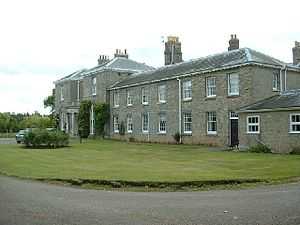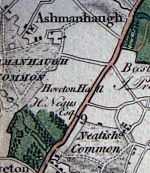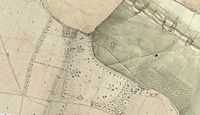Hoveton Hall

Hoveton Hall, Hoveton in Norfolk is an historic house of significance on the English Heritage Register.[1] It is a well preserved Regency house of gault brick with a slate roof and was built between 1809 and 1812 by Humphry Repton, the well-known architect and landscape designer. Today it is part of an estate of 120 acres of gardens and parkland and 450 acres of arable land as well as picturesque woodland. The gardens are open to the public during part of the year and there are facilities available for accommodation and special events particularly weddings.
Early History of Hoveton Hall Estate

There was a manor house called Hoveton Hall on the property which was demolished when the new house was built in 1809. The site of this old manor is unclear as no part of the building remains. However Basil Cozens-Hardy analysed the existing maps and data and concluded.
"It would seem that the original hall was near the kitchen garden in the park, as a map and schedule of about 1840 (see map below) calls the field to the south-west " the Old Hall Close”. Moreover in Faden’s map of 1797 (see map on right) the hall is shown at this point with an avenue running down to the road."[2]
Christabell Burroughes
The originator of Hoveton Hall was Christabell Burroughes who commissioned Humphry Repton[3] to construct the mansion in 1809.
Christabell was born in 1764. Her father was Henry Negus (1734-1807) a solicitor who worked in Bungay, Suffolk but who also owned Hoveton Hall.[4] The Negus family had for a long time been wealthy landowners in the Hoveton area.
In 1789 Christabell married James Burkin Burroughes who had inherited Burlingham Hall in Norfolk[5] (now demolished). The couple lived at Burlingham Hall for some time but unfortunately in 1803 at the age of only 43 James died leaving Christabell to care for seven sons and one daughter.[6]


She remained at the Hall for several years. In 1807 her father Henry Negus died and as she was his sole heir she became owner of Hoveton Hall with its existing old manor house. Possibly because her eldest son Henry Negus Burroughes was to turn 21 in 1812 and therefore inherit Burlingham Hall, she decided to build her own house at Hoveton. By 1812 the new house was complete and she moved there with her younger children. She suffered a severe loss three years later when two of her sons James and Edward who had been sent to Cambridge University died there within a week of each other because of an outbreak of an infectious fever.[7]
Christabell was a very good gardener and was mentioned frequently in the gardening magazines of the time. She had the walled garden constructed early as it is shown in the Enclosure Map of 1828. In 1841 James Grigor, a botanist visited Hoveton Hall and gave a very favourable account of the garden. Some of the extracts are as follows.
"Though evening was darkening around us when we visited this place, we had sufficient time to perceive that it ranks deservedly high as a seat of general excellence…Whilst the flower-garden here is of such perfect character, the scenes of the shrubbery and pleasure-ground are of an equally interesting description. The shrubbery is a well-managed piece of work, successfully blended with the lawn of the pleasure-ground, and though modern, already contributing to the general beauty of the place. The most elegant part of the picture lies betwixt the hall and the kitchen-garden, a locality which art has rendered very ornamental, and where the shrubs are assuming a high degree of beauty. The whole place is so judiciously laid out, that we hazard the opinion that it has been done by someone who has become eminent in his profession.
The trees here form a grand sight. They are chiefly of the oak tribe, and at the south-west side of the mansion they rise in the form of an avenue. The elegant manner in which this seat is kept, combined with the extensive and well-assorted collection of flowers and shrubs which it contains, merits our highest praise."[8]
In 1843 Christabell died and her eldest son Henry Negus Burroughes inherited Hoveton Hall.
Henry Negus Burroughes
After he inherited Hoveton Hall in 1843 Henry Negus Burroughes continued to live at his main residence Burlingham Hall. However his younger brother William lived at Hoveton Hall for some time.[9]
In about 1850 John Gurney (1809-1856) and his wife Laura[10] rented the house. His daughter Catherine was born there. John was part of the wealthy Gurney family who had established the Norwich Bank. His father Samuel Gurney (1786-1856) was known as a prominent banker and philanthropist. John moved to his ancestral home Earlham Court a few years later and died there in 1856 at the age of only 44 leaving Laura to care for the children. Interestingly a century later John’s great grandson Desmond Gurney Buxton bought Hoveton Hall and lived there for many years (see below).
After John Gurney moved from the Hall the Reverend Randall Burroughes (1829-1872) moved there with his family. Randall Burroughes was the son of Henry Negus Burroughes. In 1852 he married Emily Harbord who was the daughter of Edward Harbord 3rd Baron Suffield. The couple lived at Hoveton Hall until 1872 when Randall died.[11] In the same year Henry Negus Burroughes died and the Hall was sold. Sir Jacob Henry Preston bought the property in 1873.[12]
Sir Jacob Henry Preston
Sir Jacob Henry Preston (1812-1891)[13] owned Beeston Hall near Hoveton and continued to live there after he purchased Hoveton Hall.[14] He was related to the Burroughes family by marriage as his sister Pleasance had married Jeremiah Burroughes a son of Christabell. After Sir Jacob Henry Preston died in 1891 his son and subsequently his grandson, Sir Jacob Preston (1887-1818) inherited the property and they all appear to have rented it to tenants.
John Barwell (1825-1912) a wealthy wine merchant and his wife Sabine rented the house from about 1875 until after 1881.[15] Sir James William Malcolm was a very long term tenant living there from about 1890 to after 1901.[16] He was a Captain in the Royal Pembroke Artillery Militia.[17]
Twentieth Century Owners

In 1912 Sir Jacob Preston, the grandson of the first Preston owner, sold the Hall to Reverend John Hare Beevor (1861-1914).[18] After his death two years later in 1914 his wife Susan continued to live at the property but she decided to sell it in 1919.
The new owner was Geoffrey Fowell Buxton (1852-1929) who was a Director of the Barclay Bank. He was also involved in the Volunteer movement and was the second in command of the 1st Battalion of the Norfolk Regiment. In 1903 he was the Mayor of the Norwich Town Council.[19] When he died in 1929 his wife Mary put the property on the market. An advertisement for the sale of the house is shown.
George Cradock bought the house but unfortunately his wife Eunice died in 1934 and he put the property up for sale the following year. Captain Henry Douglas Clark (1889-1952) who was the son of a very prominent shipbuilder purchased the house and made substantial renovations. In 1946 Douglas Buxton bought the Hall and it has remained in the Buxton family since then.
References
- ↑ English Heritage, “Hoveton Hall”. Online reference http://list.english-heritage.org.uk/resultsingle.aspx?uid=1373443
- ↑ Coxens-Hardy, Bazil, “Some Norfolk Houses”, Norfolk Archaeology”, Vol 32, 1961, p. 187.
- ↑ Wilson, Richard (12 March 2015). Creating Paradise. Google Books. Retrieved 24 March 2015. p. 39.
- ↑ Norfolk Chronicle, 15 August 1807, p. 1.
- ↑ Burke, John (12 March 2015). A Genealogical and Heraldic History of the Commoners of Great Britain and Ireland, Enjoying Territorial Possessions Or High Official Rank. Google Books. Retrieved 24 March 2015. vol 3, p. 553.
- ↑ The East Anglian. Google Books. 12 March 2015. Retrieved 24 March 2015.Volume 1, p. 427.
- ↑ The East Anglian: Or Notes and Queries on Subjects Connected with the Counties of Suffolk, Cambridge, Essex and Norfolk, Volume 1, p. 427. Online reference http://books.google.com.au/books?id=AhM-AQAAMAAJ&pg=PA427&dq=christabel+burroughes&hl=en&sa=X&ei=2qfIU-yTNYOB8gXSnYHQCw&ved=0CDkQ6AEwBjgK#v=onepage&q=christabel%20burroughes&f=false
- ↑ Grigor, James, 1841 “The eastern, arboretum; or, Register of remarkable trees, seats, gardens, etc., in the county of Norfolk”, p. 162. Online reference https://archive.org/stream/easternarboretu00griggoog#page/n233/mode/2up
- ↑ White’s 1945 Norfolk Directory. Online reference http://books.google.com.au/books?id=e64yAQAAMAAJ&q=%22william+burroughes%22+hoveton&dq=%22william+burroughes%22+hoveton&hl=en&sa=X&ei=7prMU8ikPIX68QXvw4KwCw&ved=0CCUQ6AEwAg
- ↑ English Census of 1851 and “History, Gazetteer, and Directory of Norfolk, and the City and County of the City of Norwich”, p. 545. Online reference http://books.google.com.au/books?id=GEIJAAAAIAAJ&pg=PA545&dq=burroughes+hoveton&hl=en&sa=X&ei=UHHLU_avAZHs8AXL3IGADA&ved=0CCoQ6AEwAzgU#v=onepage&q=burroughes%20hoveton&f=false and also Online reference http://books.google.com.au/books?id=ypc9AQAAMAAJ&pg=RA1-PA166&dq=%22john+gurney%22+hoveton&hl=en&sa=X&ei=Y6jMU4CIN8P38QXMpoCoCw&ved=0CCAQ6AEwAQ#v=onepage&q=%22john%20gurney%22%20hoveton&f=false
- ↑ The Peerage website. Online reference http://thepeerage.com/p14744.htm#i147438
- ↑ The National Archives, Agreement of sale 1873. Online reference http://apps.nationalarchives.gov.uk/a2a/records.aspx?cat=153-mc36&cid=1-5-2#1-5-2
- ↑ The Peerage website. Online reference http://www.thepeerage.com/p6206.htm#i62056
- ↑ England Census of 1871, 1881 and 1891.
- ↑ List of Carthusians, 1800 to 1879. Online reference http://books.google.com.au/books?id=hSISAwAAQBAJ&pg=PA15&dq=%22hoveton+hall%22&hl=en&sa=X&ei=uLzMU4WcMsOn8AX1wYDYAg&ved=0CDAQ6AEwBDgU#v=onepage&q=%22hoveton%20hall%22&f=false and the England Census of 1881.
- ↑ England Census of 1891 and 1901.
- ↑ Fox-Davies, Arthur Charles, 1899 “Armorial families”, p. 557. Online reference https://archive.org/stream/familiesarmorial00foxdrich#page/556/mode/2up
- ↑ Alumni Cantabrigienses: A Biographical List of All Known Students, Graduates and Holders of Office at the University of Cambridge, from the Earliest Times to 1900, Volume 2. Online reference http://books.google.com.au/books?id=WPPcP39XDDIC&pg=PA216&lpg=PA216&dq=beevor+%22hoveton+hall%22&source=bl&ots=ULbGkgqGBI&sig=Be_epB3e2vxh2S9-6x9d_Qja3tQ&hl=en&sa=X&ei=Y-rNU9vdEI-i8AW-swI&ved=0CCMQ6AEwAQ#v=onepage&q=beevor%20%22hoveton%20hall%22&f=false
- ↑ The Times (London) Apr 12, 1929; pg. 16. Online reference https://commons.wikimedia.org/wiki/File:Obituary_Geoffrey_Buxton_1929.jpg